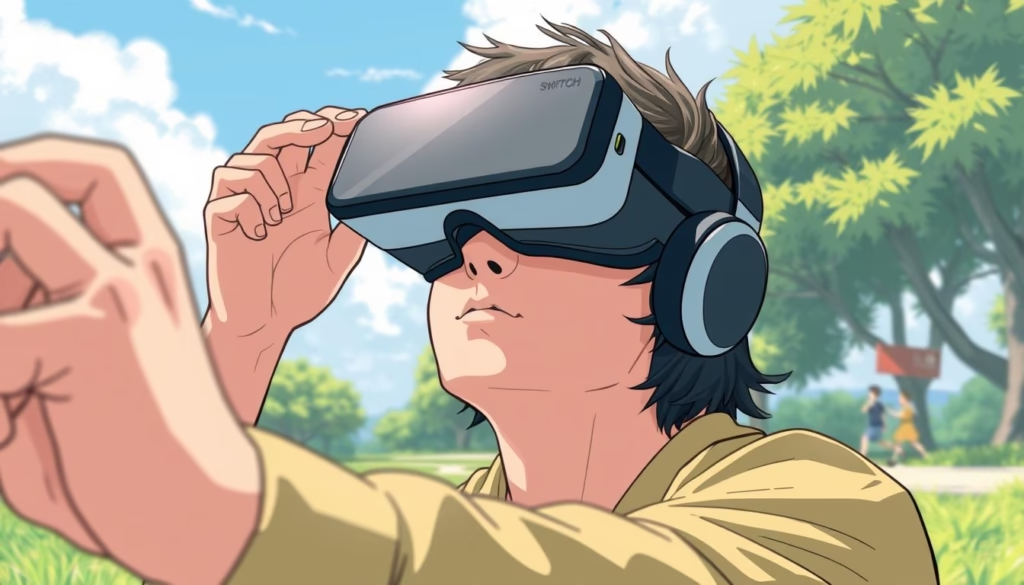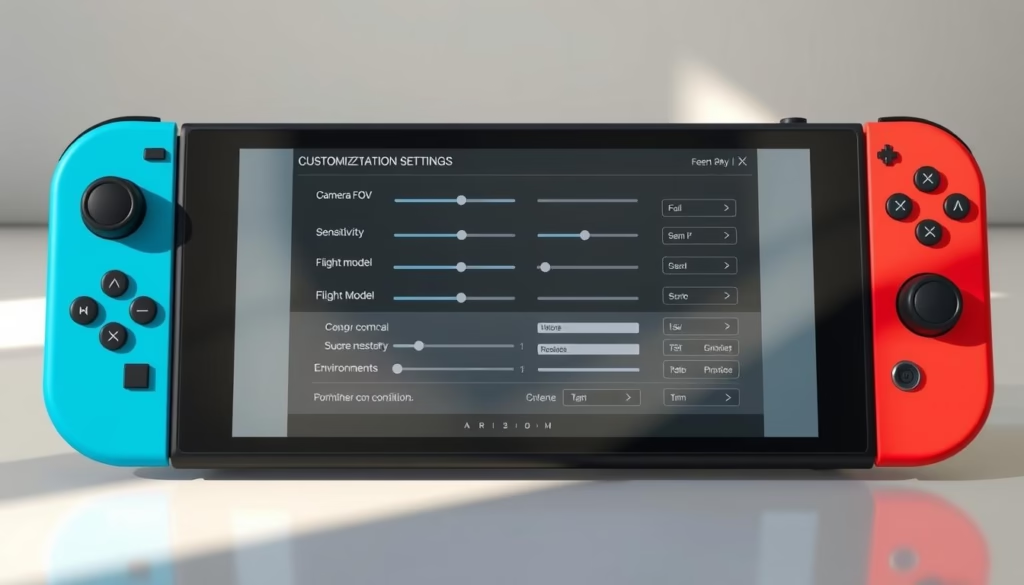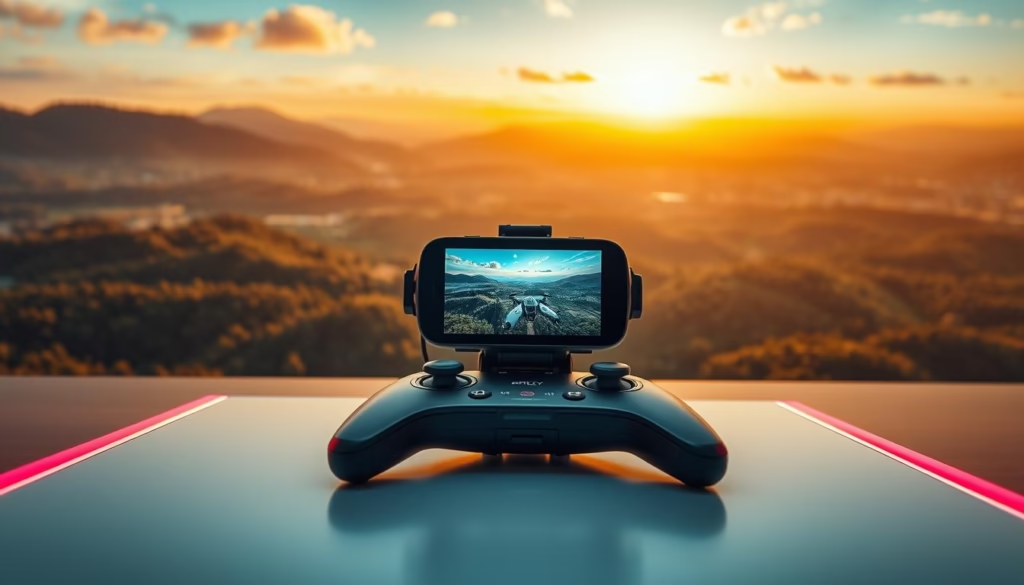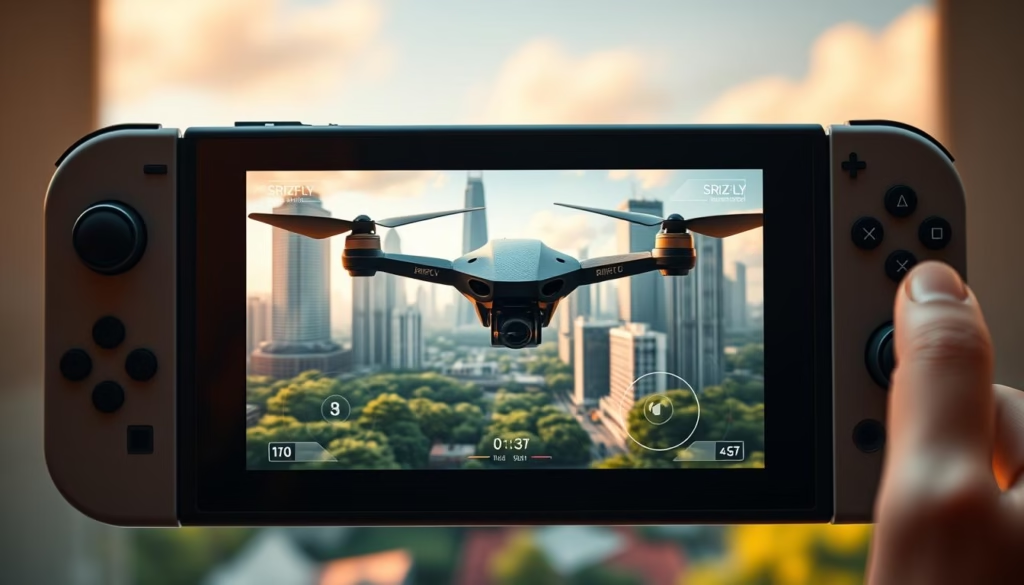Experience the thrill of first person view drone flying without the risk of damage or financial loss. The Nintendo Switch FPV Simulator offers a revolutionary way to master complex drone maneuvers in a safe and controlled environment. We are committed to delivering the best solutions for drone enthusiasts and professionals alike.
With the simulator, you can explore structured learning paths designed for both beginners and advanced pilots. This innovative tool bridges the gap between novice and expert, providing a comprehensive training experience. By leveraging the portability and precision of the Nintendo Switch, you can hone your skills anywhere, anytime.
Key Takeaways
- Revolutionary drone pilot training in a risk-free environment
- Ideal balance of portability and control precision for drone simulation
- Structured learning paths for complete beginners and advanced pilots
- Comprehensive features for standout drone training
- Experience the thrill of FPV drone racing and freestyle without financial risk
The Growing Popularity of FPV Drone Simulation
The popularity of FPV drone simulation is growing rapidly, driven by its benefits for beginners and professionals alike. As the FPV community expands, more pilots are turning to simulation as a vital step in their training process.
What is First Person View (FPV) Flying?
First Person View (FPV) flying provides an immersive experience, allowing pilots to see exactly what their drone sees through video goggles or screens. This method differs significantly from traditional line-of-sight drone piloting, offering a more engaging and challenging experience.
Why Simulation is Essential for Beginners
Simulation is crucial for beginners because it provides a safe environment to learn and practice FPV flying. It helps to reduce the steep learning curve associated with FPV, allowing pilots to master skills before moving to real-world flying. As a result, pilots can avoid damaging their equipment and minimize the financial impact of mistakes.
As quoted by a renowned FPV pilot, “Simulation has been a game-changer for me. It allowed me to practice and refine my skills without the fear of crashing or damaging my drone.”
“Using FPV simulation has been instrumental in my training. It has helped me to understand the intricacies of FPV flying and prepare for real-world challenges.”
Advantages of Using Nintendo Switch for FPV Simulation
With its hybrid design, the Nintendo Switch offers an ideal environment for FPV simulation, combining the best of both worlds. This versatility provides several key advantages to users.
Portability and Convenience Factors
The Nintendo Switch’s portability is a significant advantage for FPV simulation. Users can practice anywhere, whether during commutes or travel downtime, thanks to its self-contained design and battery life. The system’s plug-and-play nature removes technical barriers, making it easy for beginners to start practicing without additional hardware.
Controller Ergonomics for Drone Piloting
The ergonomics of the Nintendo Switch controllers enhance the FPV simulation experience. The detachable Joy-Con controllers provide a realistic approximation of actual drone transmitter sticks, while the ergonomic design of the Switch Pro Controller offers comfort during extended practice sessions.
Key features of the Nintendo Switch that enhance FPV simulation include:
- High-performance processing for smooth frame rates
- Built-in screen for clear visuals
- Portable and versatile design
- Ergonomic controllers Plug-and-play simplicity
Here is a comparison of the key features of different FPV simulation platforms:
| Feature | Nintendo Switch | PC | Mobile |
|---|---|---|---|
| Portability | High | Low | High |
| Processing Power | High | Very High | Medium |
| Controller Ergonomics | Good | Variable | Poor |
| Visual Clarity | High | Very High | Medium |
Nintendo Switch FPV Simulator: The Premier Option
For those looking to master FPV drone racing, the Nintendo Switch FPV Simulator stands out.

Overview
The Nintendo Switch FPV Simulator is a comprehensive training tool for FPV drone pilots. It is designed for FPV enthusiasts of all skill levels, from beginners to advanced pilots. The simulator offers two main game modes: Time Trial and free flight mode.
Pros
The simulator provides a realistic FPV experience, allowing users to practice racing and freestyle maneuvers. The simulator is praised for its realistic physics engine and progressive difficulty system.
Cons
Some users may find that the simulator has limitations compared to PC-based simulators. However, its convenience and portability make it an attractive option.
Features
The simulator includes a Time Trial mode for competitive practice and a free flight mode for practicing freestyle tricks. The FPV simulator is designed to help users improve their skills in a controlled environment.
Complete Flight School: From Novice to Expert
The flight school feature in the Nintendo Switch FPV simulator is designed to take pilots from novice to expert. It is a comprehensive program that teaches fundamental FPV drone racing gates and controls through a series of well-structured tutorials.
7 Progressive Tutorials Structure
The flight school is made up of 7 progressive tutorials, each designed to build upon the previous one, creating a logical flight pathway for skill development. This progression ensures that pilots learn at a steady pace, mastering each step before moving on to the next.
Fundamental Racing Gates and Controls
As part of the tutorials, users are introduced to FPV racing gates gradually, developing their spatial awareness and precision flying skills. The simulator focuses on fundamental control inputs, which form the basis of all advanced flying techniques. As quoted by a renowned FPV expert,
“The key to mastering FPV is starting with the fundamentals and practicing consistently.”
Through this complete flight school, pilots can expect to gain a solid foundation in FPV drone handling, preparing them for both structured racing and creative freestyle flying. The tutorials break down complex maneuvers into manageable parts, and features like instant reset allow for rapid practice without frustrating delays.
Racing Experience: Time Trial Mode
Get ready to put your FPV skills to the test in the thrilling Time Trial mode of the Nintendo Switch FPV Simulator. With six challenging race tracks designed to test different piloting skills, you’ll need to master various techniques to succeed.
6 Challenging Race Tracks
The simulator features six distinct racing tracks, each introducing unique obstacles and gate patterns that require specific piloting techniques. As you progress through the tracks, the difficulty curve becomes increasingly challenging, pushing you to improve your FPV racing skills.
| Track | Obstacles | Skill Level |
|---|---|---|
| Track 1 | Simple gates | Beginner |
| Track 2 | Narrow tunnels | Intermediate |
| Track 3 | Sharp turns | Advanced |
| Track 4 | Multiple gates | Intermediate |
| Track 5 | Timed gates | Expert |
| Track 6 | Complex course | Pro |
Beat Your Last Best Time Challenge
In Time Trial mode, you’re encouraged to try to beat your last best time. The instant lap time feedback and ghost drone feature allow you to compare your current run against your best previous attempts, creating a rewarding loop of continuous improvement. By analyzing your performance through detailed analytics, you can identify areas for improvement and refine your FPV skills.
Freestyle Practice: Free Flight Mode
Free flight mode in the Nintendo Switch FPV Simulator is designed for pilots to hone their freestyle skills without restrictions. This mode allows you to fly around and perform various tricks in a risk-free environment.
Diverse Flight Environments
The simulator offers six distinct flight environments that inspire creative flying and freestyle trick development. Each environment is uniquely designed with different obstacles and features that facilitate various FPV techniques.
- Explore the varied landscapes and structures designed to challenge and engage pilots.
- Analyze how each environment’s unique features can be used to master different freestyle maneuvers.
Perfecting Tricks Without Crash Anxiety
In free flight mode, pilots can focus on perfecting complex maneuvers without the pressure of time or the fear of crashing. The instant reset feature removes the anxiety associated with real-world practice, allowing for more aggressive and experimental flying. You can fly around and try around freestyle tricks without worrying about damage.
Customization Options in Nintendo Switch FPV Simulator
The Nintendo Switch FPV simulator offers various customization options to enhance your FPV experience. As you progress from a beginner to an advanced pilot, being able to customize the simulator to fit your skill level and preferences is crucial.
Predefined Drone Settings for Different Skill Levels
The simulator comes with three predefined drone settings designed to match different skill levels, from beginner to advanced. These settings alter the flight characteristics, including stability, responsiveness, and speed, allowing users to gradually adapt to more challenging environments as their skills improve. For instance, the beginner setting provides more stability, while the advanced setting offers more responsiveness and speed.

Stick Sensitivity Configurations per Axis
Users can fine-tune their experience further with four stick sensitivity configurations per control axis. This allows for precise adjustments to match personal preferences, enhancing the overall experience. By adjusting the stick sensitivity, users can achieve a more realistic feel that closely mimics their real-world equipment, thus helping to get into the world of FPV racing more seamlessly.
These customization options help bridge the gap between the simulator and real-world flying, making the transition smoother. Moreover, the ability to save multiple profiles allows for experimentation without losing preferred settings. This feature is particularly beneficial as it allows pilots to keep their preferred settings while trying out new configurations, thus enhancing their learning efficiency and skill development in the FPV simulator.
Skill Progression System
The Nintendo Switch FPV simulator incorporates a skill progression system to help pilots master FPV flying. This system is designed to take you through different levels of difficulty as you improve your skills.
Beginner Mode: Getting Comfortable with Controls
In beginner mode, the simulator introduces stabilization and simplified physics, making it easier for new pilots to get comfortable with the controls. This mode is crucial for understanding the basics of FPV flying without being overwhelmed by complex flight dynamics.
Intermediate Mode: Building Advanced Skills
As you progress to the intermediate mode, the training aids are gradually removed, and the flight dynamics become more realistic. This mode challenges you to refine your skills and prepare for more complex maneuvers.
Pro Mode: Unlocking Full FPV Potential
Finally, the pro mode delivers the full simulation experience, with physics that closely match real-world drone behavior. This mode is ideal for those who have mastered the basics and intermediate skills and are ready to experience the full potential of FPV flying, including freestyle and fast racing.
Through this three-tiered progression system, you can gradually build your skills, from getting comfortable with the controls in beginner mode to mastering advanced techniques in pro mode. The clear progression path provides motivation through achievable milestones, and upon completing all three modes, you will be well-prepared for the full range of real-world flying scenarios.
Here is an overview of the skill progression system:
| Mode | Characteristics | Skills Developed |
|---|---|---|
| Beginner | Stabilization, simplified physics | Basic control, understanding of FPV basics |
| Intermediate | Gradual removal of training aids, more realistic dynamics | Refined skills, more complex maneuvers |
| Pro | Real-world physics, full simulation experience | Freestyle, fast racing, advanced FPV techniques |
Alternative Flight Simulators for Nintendo Switch
Beyond the Nintendo Switch FPV Simulator, other flight simulators on the Nintendo Switch offer varied experiences for pilots.
These alternative simulators can provide different skill sets and experiences, some of which might complement the FPV simulator, while others offer distinct types of flight experiences.
Insert Before Flight
Insert Before Flight is a flight simulator that focuses on small aircraft, allowing users to fly different aircraft and choose from various environments.
It offers a different focus compared to the FPV simulator, focusing on small aircraft simulation instead of FPV drone experience.
Image prompt:
Pilot Sports
Pilot Sports offers a wide variety of aircraft that control and feel differently, providing a more casual, arcade-style approach to flight.
This simulator is different from the dedicated FPV simulation, as it focuses on a broad range of aircraft and flight experiences.
Image prompt:
Stunt Flyer
Stunt Flyer: Kid Adventures: Sky Captain includes 40 exhilarating missions from sky racing, stunt flying, target shooting, and treasure hunting.
This mission-based structure differs from the skill-development focus of the FPV simulator, offering a more mission-oriented experience.
Image prompt:
Korean Drone Flying Tour
Korean Drone Flying Tour Chuncheon City is a simulation game where users can directly operate a drone based on actual drone flight footage.
It uses actual flight footage, differing from the fully digital environments of other simulators, and provides a unique experience.
Image prompt:
Each of these simulators has its strengths and limitations, and some may complement the FPV simulator for developing different aspects of flight proficiency.
Simulator vs. Real-World Flying: Skill Transfer
As FPV enthusiasts transition from simulation to real-world flying, understanding the skill transfer between these environments is crucial. The effectiveness of FPV simulators in preparing pilots for actual drone flying depends on several factors.
Physics Accuracy and Limitations
The physics engine accuracy in FPV simulators plays a significant role in replicating real-world drone flight characteristics. While simulators can model many aspects of drone behavior, they often simplify or omit certain factors like weather conditions.
How Simulator Practice Translates to Real Drones
Muscle memory developed through simulator practice can transfer directly to actual transmitter controls, improving pilot performance. Pilots who train extensively in simulators demonstrate faster skill acquisition with real equipment.
Maximizing Your FPV Simulator Training
To get the most out of your FPV simulator, it’s essential to adopt a strategic approach to training. Effective training involves a combination of structured practice and progressive challenges that help FPV pilots improve their skills.
Structured Practice Routines
Breaking your training into focused 15-30 minute sessions can significantly improve retention compared to marathon practice sessions. Alternating between racing and freestyle practice helps develop complementary skill sets. Deliberate practice focusing on weak areas yields faster improvement than casual flying.
| Practice Method | Benefits |
|---|---|
| Structured Sessions | Improved retention, focused skill development |
| Racing and Freestyle Alternation | Complementary skill sets, enhanced overall proficiency |
| Deliberate Practice | Faster improvement, targeted skill enhancement |
Setting Progressive Challenges
Creating personal challenges beyond the built-in objectives maintains engagement and progress. Recording and reviewing flights helps identify areas needing improvement. Establishing measurable goals creates a clear pathway to advanced piloting proficiency with your drone simulator.

Technical Requirements and Setup
To enjoy the Nintendo Switch FPV Simulator, you’ll need to ensure your system meets the necessary technical specifications. This involves understanding the purchase process and the system requirements.
Nintendo eShop Purchase Process
Purchasing the Nintendo Switch FPV Simulator is straightforward through the Nintendo eShop digital storefront. The payment is made using Nintendo eShop funds linked to your Nintendo Account. After the payment is processed, the content is downloaded to the system linked to your Nintendo Account, which must be updated to the latest system software and have automatic downloads enabled.
Storage and System Requirements
The Nintendo Switch FPV Simulator has minimal storage requirements, making it accessible even on systems with limited space. Ensure your system has enough storage to complete the download. The simulator requires a Nintendo Switch system updated to the latest software. The digital delivery system ensures you always have access to the latest version with bug fixes.
Conclusion: Taking Your FPV Skills to New Heights
Entering the world of FPV, the Nintendo Switch FPV simulator stands out as a premier training platform. It provides a complete pathway from beginner to advanced pilot, allowing users to master FPV skills without the fear of crashing.
By mastering skills in the simulator, users can enjoy significant financial benefits before investing in expensive FPV drone equipment. The combination of structured tutorials and free practice modes creates well-rounded piloting abilities.
The simulator’s portability ensures consistent practice regardless of weather or location. The skills developed transfer directly to competitive racing and creative freestyle flying. Even after moving to real drones, the simulator continues to be beneficial. We evaluate the simulator as an essential tool in the modern drone pilot’s learning arsenal. As FPV simulation evolves alongside drone technology, it remains a vital component of drone training.
FAQ
What is the main purpose of using a drone simulator?
The main purpose of using a drone simulator is to practice and improve your drone piloting skills in a virtual environment, reducing the risk of damage to your drone and improving your overall performance.
What are the benefits of using a FPV simulator for drone racing?
Using a FPV simulator for drone racing provides a realistic and immersive experience, allowing you to practice and refine your skills, including navigating through challenging race tracks and improving your reaction time.
Can I customize the settings in the FPV simulator?
Yes, you can customize the settings in the FPV simulator, including predefined drone settings for different skill levels and stick sensitivity configurations, to suit your needs and skill level.
How does the simulator help in learning freestyle tricks?
The simulator provides a safe and controlled environment to practice and perfect freestyle tricks, allowing you to experiment with different maneuvers and techniques without the fear of crashing or damaging your drone.
Is the FPV simulator suitable for beginners?
Yes, the FPV simulator is suitable for beginners, providing a gradual learning curve and tutorials to help you get started with drone piloting and FPV flying.
Can I use the FPV simulator to improve my real-world flying skills?
Yes, the FPV simulator can help improve your real-world flying skills, as the skills you practice and refine in the simulator, such as reaction time and navigation, can be transferred to real-world flying.
What are the system requirements for the FPV simulator on the Nintendo platform?
The system requirements for the FPV simulator on the Nintendo platform include sufficient storage space and a compatible system software version, which can be checked on the Nintendo eShop.
Can I practice time trial mode in the FPV simulator?
Yes, the FPV simulator offers a time trial mode, allowing you to practice and challenge yourself to beat your last best time on various race tracks.



